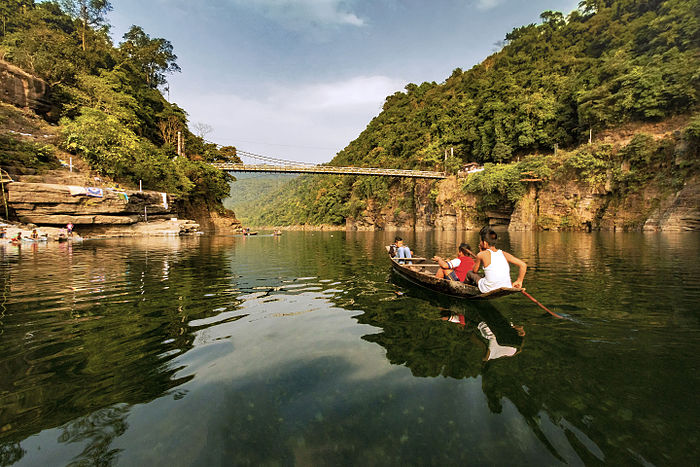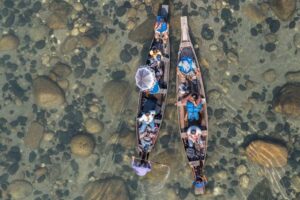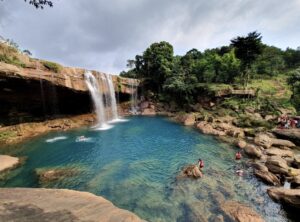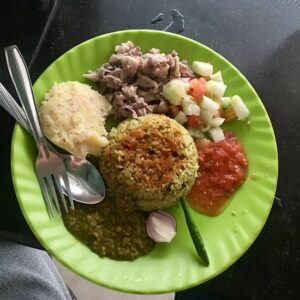Dawki: A divine discovery in Meghalaya

The Umngot river in Dawki is known as one of the cleanest rivers in India (Photo Credit: Deepak Kumar)
When Deepak Kumar, a second-year student of Psychology at the University of Delhi, visited Dawki in January this year, he felt it was nothing less than a fairy-tale in real life.
“A boat takes you along the gleaming stream that has different kinds of fish and snakes floating below and some colourful stones that lie at the bottom of the riverbed. As the boat floats along, you encounter sparkling cascades that drop down from stunning hills that are covered with green trees. Dotting the scene are twittering birds and fluttering butterflies. Further, you spot mysterious covers hidden between the ridges of the hills. Mesmerised already?” asks Kumar.
“Welcome to the real-life fairyland – Dawki, Meghalaya,” he adds.
About 80 km south of Meghalaya’s capital Shillong, lies the quaint Dawki that also boasts of connecting India and Bangladesh, not just geographically, but also culturally. It also stands as a connecting point of two major hills which are Jaintia Hills and Khasi Hills.
The Umngot river
For years now, this less explored wonder in the lap of hills and forests has gained attraction for its crystal clear waters of the Umngot river. One can easily find photographs of small ferries and boats sailing on emerald-greenish, clear water which creating the illusion that boats are floating in the air.
Considered one of the cleanest rivers in India, Umngot is the natural divide between the Jaintia and Khasi hills and it flows into Bangladesh, through Dawki.
“Apart from the Instagram-worthy river, the main attraction here is the Dawki Bridge over it,” says Kumar.
Dawki bridge is a suspension bridge and serves as a place where all tourists can enjoy some spectacular panoramic views. British officials built this bridge in 1932, which one can cross on foot for some added thrill. One can also consider camping on the river banks or go kayaking, snorkelling, and boating in the river. There are Zipline rides available as well.
Explore Shnongpdeng
Another beautiful place to visit in Dawki is Shnongpdeng, a small island in the river. “Even though it lies mostly off the radar of tourists, it is, without question, one of the best places to explore in Dawki,” Kumar adds.
Among the unknown attractions in the area are gorgeous sites like the Krang Suri waterfall and crystal clear river waters. This area is also a hotspot for camping. Once there, the next thing one must do is set off across the bamboo bridge over the river. Crossing the bridge can be a little unsettling, as it wobbles as one move across it.
Kumar warns that only seven or eight people are allowed on the bridge at a time, so be mindful of that when you visit. The bridge itself is a fantastic spot to view the stunning and lush river valley and is situated just inches above the surface of the river. “Too bad I forgot to bring my bathing suit. When you go to Shnongpdeng, don’t forget to bring yours along,” he adds.
Try the local cuisine
One is likely to build up an appetite on their way to Shnongpdeng, so Swati, a student of Social Science and a friend of Kumar’s who accompanied him while eating, suggests trying some local food. There are many delicious options to try there, including the local river fish. Start off with some rice and fish curry, which contains huge filets of river fish and has a greenish tint to it. Next, one can go for fish meat.
The traditional riverside feast also contains a marvellous and fatty beef curry. According to Swati, “This is the way beef should be: soft, tender, and bursting with incredible, mouth-watering flavour.”
Another component of the feast one will be served in Dawki is jackfruit. According to the local custom, jackfruit is mixed with spinach, bamboo, onions, peppers, and mushrooms, lightly fried and served as a side dish. Swati also points out two traditional Khasi dishes Jadoh and Doh khlieh, that one does not easily find outside Meghalaya.
Jadoh is red rice, cooked with ample amounts of pork meat. But it can also be cooked with chicken or fish. This dish has a mixture of green chillies, onions, ginger, turmeric, black pepper and thereafter pieces of pork are added and fried, following which the red rice is added and cooked off.
Adding turmeric gives the rice a rich yellow colour and an aroma. “Interestingly, Jadoh can also be cooked in pig blood. This is a must-try dish if you are in Meghalaya,” adds Swati.
Another famous dish of Meghalaya and a speciality of Dawki region is Doh khlieh. It is pork salad prepared with pig’s brain mixed with finely chopped onions, green chillies, ginger and seasonings.
Contemporary cooks and restaurants also add Mexican touch to Doh khlieh by adding beans, tomatoes, carrots and lemons. It tastes best when eaten with bread.













